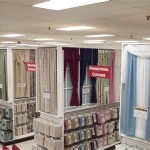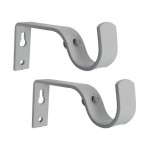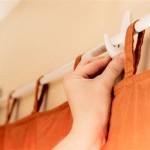Different Types of Curtain Rings: A Comprehensive Guide
Curtain rings are essential hardware components that facilitate the smooth movement of curtains along a curtain rod. While seemingly simple, a diverse array of curtain ring types exist, each designed to suit specific curtain weights, rod diameters, aesthetics, and functional requirements. This article provides a detailed exploration of the various types of curtain rings available, highlighting their distinguishing features, benefits, and appropriate applications.
The selection of appropriate curtain rings involves considering several factors. These include the overall weight of the curtain fabric, the diameter of the curtain rod, the desired aesthetic, and the ease of installation and manipulation. Inappropriate selection can lead to operational difficulties, such as rings sticking to the rod or causing excessive friction, premature wear and tear on the curtains or rings, and an undesirable visual impact.
Basic Curtain Ring Materials and Construction
The construction of curtain rings generally involves a circular or near-circular body, often with an attachment point for the curtain. The materials used in their construction significantly influence their durability, weight capacity, and aesthetic appeal. Common materials include:
Metal: Metal rings are typically manufactured from steel, brass, iron, or aluminum. Steel provides excellent strength and durability, making it suitable for heavy curtains. Brass rings offer a classic, elegant appearance and are resistant to corrosion. Iron rings provide a rustic and robust aesthetic. Aluminum rings are lightweight and corrosion-resistant, making them suitable for lighter curtains and humid environments. Metal rings are often finished with various coatings, such as paint, powder coating, or plating, to enhance their appearance and protect them from corrosion. Finishes can range from polished chrome to antique bronze, allowing for seamless integration with various decor styles.
Plastic: Plastic rings are commonly made from materials such as polypropylene or nylon. They offer a cost-effective alternative to metal rings and are lightweight and resistant to moisture. Plastic rings are available in a wide range of colors and finishes. However, they may lack the strength and durability of metal rings, and are therefore more suitable for lightweight curtains. Over time, exposure to sunlight can lead to degradation in some types of plastic rings making them brittle and prone to breakage.
Wood: Wooden curtain rings provide a natural and rustic aesthetic. They are typically made from hardwoods such as oak, maple, or birch. Wood rings can be stained, painted, or left unfinished to match the desired decor. While aesthetically pleasing, wood rings may be susceptible to moisture damage and require periodic maintenance to prevent warping or cracking. The inner surface of wooden rings often requires smoothing to minimize friction against the curtain rod.
Types of Curtain Rings Based on Attachment Mechanisms
The method by which the curtain ring attaches to the curtain fabric is a critical factor in determining its suitability for different types of curtains. Several distinct attachment mechanisms are available, each offering unique advantages and disadvantages.
Rings with Clips: These rings feature small metal or plastic clips that attach directly to the curtain fabric. Clip rings offer ease of installation and removal, making them suitable for situations where frequent curtain changes are desired. However, clips can sometimes damage delicate fabrics, and the weight capacity of clip rings may be limited, especially when using plastic clips. Care must be taken not to overload the clips or to use them on fabrics that are easily snagged or torn.
Rings with Hooks: Rings with hooks incorporate small hooks that are inserted into the heading tape or pleats of the curtain. Hook rings provide a more secure attachment than clip rings and are better suited for heavier curtains. They typically require the use of a heading tape with loops or pockets to accommodate the hooks. The hooks can be made of metal or plastic, with metal hooks offering greater strength and durability. This method generally requires more time for initial installation, but it provides a stable and visually appealing suspension.
Rings with Eyelets: Eyelet rings feature small eyelets or grommets that are sewn or pressed into the curtain fabric. The rings then slide through these eyelets, creating a clean and uniform appearance. Eyelet rings are particularly well-suited for grommet-top curtains, providing a smooth and even distribution of weight. The eyelets are typically made of metal or plastic and are available in a variety of sizes and finishes. This method provides a very secure and aesthetically pleasing finish, but the initial installation and eyelet placement must be precise.
Sew-on Rings: As the name implies, sew-on rings are directly sewn onto the curtain fabric. These rings provide a very secure and permanent attachment. However, they require more time and effort to install than other types of rings. Sew-on rings are often used for custom-made curtains or for situations where a particularly strong and durable attachment is required. The fabric around the sewn area must be reinforced to prevent tearing under load.
Specialized Curtain Ring Designs and Features
Beyond the basic categories, several specialized curtain ring designs cater to specific requirements and preferences. These designs often incorporate unique features that enhance functionality, aesthetics, or ease of use.
Silent Rings: These rings are designed to minimize noise during curtain movement. They often incorporate a plastic or nylon lining on the interior surface to reduce friction against the curtain rod. Silent rings are particularly useful in bedrooms or other noise-sensitive environments. The lining typically requires minimal maintenance, but should be checked periodically for wear and tear.
Ball Bearing Rings: Ball bearing rings feature small ball bearings that allow the rings to glide smoothly along the curtain rod. They are particularly well-suited for heavy curtains or for situations where smooth and effortless curtain movement is desired. Ball bearing rings are more expensive than standard rings, but they offer superior performance and durability. They may require periodic cleaning to remove dust and debris that can impede their smooth operation.
Extendable Rings: Extendable rings allow the curtain to hang lower than the curtain rod, providing additional light blockage or privacy. They feature an adjustable extension arm that connects the ring to the curtain. Extendable rings are particularly useful for situations where the curtain rod is mounted too high or where a longer curtain length is desired. The extension arm must be adequately reinforced to handle the weight of the curtain without bending or breaking.
Decorative Rings: Decorative rings are designed to enhance the aesthetic appeal of the curtains. They are available in a wide range of styles, finishes, and materials, including metal, wood, glass, and ceramic. Decorative rings can feature intricate carvings, embellishments, or unique shapes. They are often used in conjunction with plain curtains to add visual interest and personality to the room. The weight and compatibility of decorative rings with the curtain rod must be considered to avoid overloading the rod.
Magnetic Curtain Rings: These rings utilize magnets to hold the curtain in place, allowing for easy opening and closing. They are particularly useful for lightweight curtains or for situations where a temporary curtain solution is desired. Magnetic rings are easy to install and remove, and they do not require any permanent modifications to the curtain or the curtain rod. The strength of the magnets must be sufficient to hold the weight of the curtain, and the rings should be placed strategically to ensure even distribution of weight.
Curtain Rings with Liners: These rings are designed with a fabric or felt liner on the inner surface. These liners protect the curtain rod from scratches and damage and also reduce friction, allowing the curtains to glide smoothly. Rings with liners are especially beneficial for delicate or antique curtain rods that can be easily scratched. The liner material requires occasional cleaning to prevent the accumulation of dust and dirt, which can impede movement.
Rustproof Curtain Rings: These rings are manufactured with materials and coatings that resist rust and corrosion. They're ideal for use in bathrooms, kitchens, or other humid environments. Common materials include stainless steel and plastic with a rust-resistant coating. These rings require minimal maintenance and provide long-lasting performance even in challenging conditions.
Heavy-Duty Curtain Rings: Constructed from thick, robust materials, these rings are designed to support very heavy curtains, such as blackout curtains or lined drapes. They often feature reinforced construction, such as welded seams or thicker metal components, to prevent bending or breaking under significant weight. Heavy-duty rings are essential for ensuring the safe and reliable suspension of heavy window treatments.
Split Curtain Rings: Split rings feature a small opening or split in the ring, allowing them to be easily attached to or removed from the curtain rod without having to remove the rod itself. This makes them particularly convenient for situations where frequent curtain changes or adjustments are required. The split must be sufficiently strong to prevent the ring from coming apart under the weight of the curtain.
Button Curtain Rings: These rings are similar to sew-on rings but are typically attached using a button closure or similar fastening method. They offer a secure attachment and are often used for custom-made curtains or for situations where a more decorative attachment is desired. The strength of the button and the surrounding fabric must be considered to ensure that the rings can support the weight of the curtain.
In conclusion, the selection of appropriate curtain rings is crucial for ensuring both the functionality and aesthetics of window treatments. By understanding the different types of rings available and their respective advantages and disadvantages, consumers can make informed decisions that result in optimal performance and visual appeal. The selection process should involve careful consideration of curtain weight, rod diameter, attachment method, and desired aesthetic to ensure a harmonious and durable installation.

Ing White Curtains Or Drapes Here Is Your Guide

10 Diffe Types Of Curtain Hooks Best 2025

10 Diffe Types Of Curtain Hooks Multiple Styles For All Window Treatments

Wooden Curtain Ring House Accessories For Home Circle Hooks 2 Pcs Stainless Steel Clothes Rack Curtains Rods Wal Com

Types Of Curtain Rings Styles Materials Sizes Guide

Types Of Drapery Tops Pinch Pleat Is The Same As French Two Prong Pleats Are Good For Showing Off A Patterned Fabric And Using More Rings Grommets Casual

Curtain Rings 32mm With Hook For Rod 19mm Or 25mm 14n Black Nickel

15 Types Of Curtain Hooks Styles Options
Valance Rods

10 Diffe Types Of Curtain Hooks Multiple Styles For All Window Treatments Youtube








